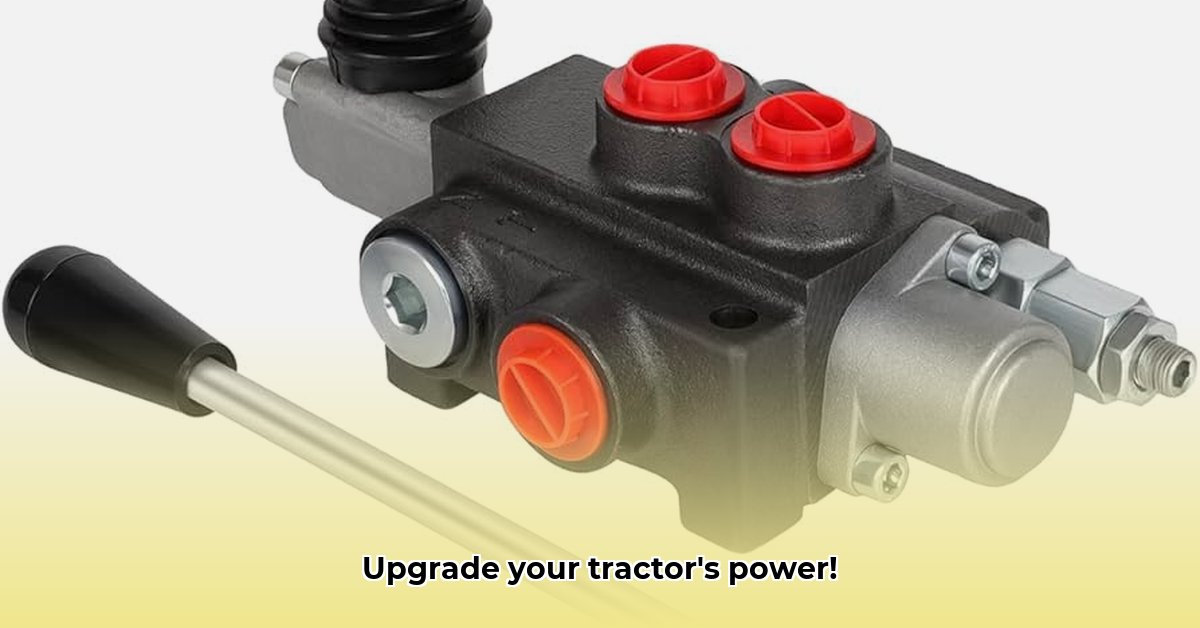
Understanding Your Tractor's Hydraulic System
Before you upgrade, understanding your tractor's hydraulic system is crucial. This is like knowing your car's engine before attempting a tune-up –– vital for success. Key parameters include:
- Hydraulic Flow Rate (GPM): (Gallons per minute) This indicates the volume of hydraulic fluid your system moves. Higher GPM usually means more power. Check your tractor's manual for this crucial specification.
- Valve Type (Open-Center vs. Closed-Center): Open-center systems release fluid when controls are neutral, while closed-center systems maintain pressure. This affects joystick compatibility. Knowing your tractor's valve type is non-negotiable.
- Spool Type ("A" or "D"): This refers to the internal valve design, affecting compatibility. Your tractor's manual should specify the spool type. Incorrect spool type can lead to malfunction and damage.
- Power Beyond Capabilities: This allows powering additional hydraulic implements without affecting the loader. If you might need this in the future, consider a system that supports it.
- SAE Port Sizes and Thread Types: These specify the size and type of fittings for hydraulic hoses. Matching these is essential to prevent leaks and damage.
For more on hydraulic hoses, check out this helpful resource. Knowing these parameters ensures compatibility with your chosen joystick system. Consult your tractor's manual or a hydraulics expert if needed. Don't skip this step; it saves you potential headaches and costly mistakes later on. Why risk a failed upgrade when a little preparation can avoid it?
Choosing the Right Joystick System
Several manufacturers, such as Shortline Parts and Summit Hydraulics, offer various joystick systems. The optimal choice depends on your tractor's specifications and your mechanical aptitude.
Shortline often provides pre-assembled kits, offering ease of installation, but limiting customization. Summit, conversely, specializes in custom configurations, allowing tailored systems, but demanding more technical skill for installation.
Here's a comparison:
| Feature | Shortline Parts | Summit Hydraulics |
|---|---|---|
| Installation Difficulty | Easy | More challenging |
| Customization Options | Limited | Extensive |
| Upfront Cost | Generally lower | Potentially higher |
| Technical Expertise Needed | Low | Moderate to High |
| Warranty and Support | Varies; check their policy carefully | Varies; check their policy carefully |
Consider your mechanical skills and budget when deciding. A pre-built kit simplifies installation, while a custom system offers greater control and potential cost savings in the long run. Research thoroughly to find options that fit your needs and budget.
"Choosing the right system depends on your skill level and budget," says John Miller, Certified Agricultural Mechanic at Miller's Tractor Repair. "A pre-built kit might be suitable for those less mechanically inclined, while a custom system offers significant advantages for experienced individuals." Remember, thorough research is key to finding the best value for your investment.
Step-by-Step Installation Guide
Safety First! Always disconnect the tractor's battery before starting any work.
- Preparation: Read the manufacturer's instructions and gather necessary tools.
- Disassembly: Carefully remove old controls and hydraulic lines, taking photos for reference. Precise labeling of connections is essential.
- Mounting: Securely mount the new valve according to the instructions, double-checking stability.
- Plumbing: Connect hydraulic lines, ensuring tight seals. Inspect all connections for leaks.
- Electrical Connections (if applicable): Connect any electrical components, following the wiring diagram meticulously.
- Testing: Reconnect the battery and thoroughly test the system, checking for leaks or malfunctions.
Troubleshooting and Maintenance for Long-Term Performance
Regular inspection of hoses, fittings, and fluid levels is essential. Addressing small issues early on prevents larger problems. Manufacturers' instructions often cover common troubleshooting issues. If problems persist, consult a hydraulic specialist. Preventive maintenance increases the lifespan of your system, reducing downtime and maximizing the return on your investment. A little regular maintenance goes a long way. Don’t delay addressing problems; a small leak today could be a major failure tomorrow.
Conclusion: Modernize Your Tractor Operation
Upgrading to a hydraulic joystick system significantly improves loader operation, providing greater control and efficiency. Careful planning, proper installation, and regular maintenance are key to ensuring a long-lasting, safe, and productive experience. Remember always to prioritize safety throughout the process.